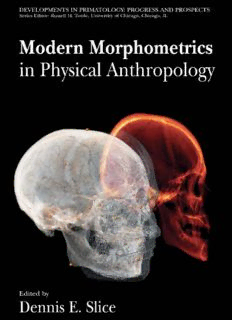
Modern Morphometrics in Physical Anthropology PDF
Preview Modern Morphometrics in Physical Anthropology
MODERN MORPHOMETRICS IN PHYSICAL ANTHROPOLOGY DEVELOPMENTSINPRIMATOLOGY:PROGRESSANDPROSPECTS SeriesEditor: RussellH.Tuttle UniversityofChicago,Chicago,Illinois This peer-reviewed book series will meld the facts of organic diversity with the continuity of the evolutionary process. The volumes in this series will exemplify the diversity of the- oreticalperspectivesandmethodologicalapproachescurrentlyemployedbyprimatologists andphysicalanthropologists.Specificcoverageincludes:primatebehaviorinnaturalhabitats andcaptivesettings:primateecologyandconservation;functionalmorphologyanddevelop- mentalbiologyofprimates;primatesystematics;geneticandphenotypicdifferencesamong livingprimates;andpaleoprimatology. ALLAPESGREATANDSMALL VOLUME1:AFRICANAPES EditedbyBiruteM.F.Galdikas,NancyEricksonBriggs,LoriK.Sheeran,GaryL.Shapiro andJaneGoodall THEGUENONS:DIVERSITYANDADAPTATIONINAFRICANMONKEYS EditedbyMaryE.GlennandMarinaCords ANIMALBODIES,HUMANMINDS:APE,DOLPHIN,AND PARROTLANGUAGESKILLS WilliamA.HillixandDuaneM.Rumbaugh COMPARATIVEVERTEBRATECOGNITION:AREPRIMATES SUPERIORTONON-PRIMATES LesleyJ.RogersandGiselaKaplan ANTHROPOIDORIGINS:NEWVISIONS CallumF.RossandRichardF.Kay MODERNMORPHOMETRICSINPHYSICALANTHROPOLOGY EditedbyDennisE.Slice MODERN MORPHOMETRICS IN PHYSICAL ANTHROPOLOGY Edited by Dennis E. Slice InstituteforAnthropology UniversityofVienna Vienna,Austria KLUWER ACADEMIC / PLENUM PUBLISHERS New York, Boston, Dordrecht, London, Moscow LibraryofCongressCataloging-in-PublicationData DennisE.Slice. Modernmorphometricsinphysicalanthropology/editedby DennisE.Slice. p. cm.—(Developmentsinprimatology) Includesbibliographicalreferencesandindex. ISBN0-306-48697-0(hardback)—ISBN0-306-48698-9(ebook) 1.Physicalanthropology—Methodology. 2.Physicalanthropology—Mathematics. 3.Physicalanthropology—Computersimulation. 4.Morphology—Mathematics.5.Morphology—Statisticalmethods. 6.Morphology—Computersimulation.7.Anthropometry. 8.Craniometry. I.Slice,DennisE. II.Series. GN50.8.M632005 599.9—dc22 2004054594 ISBN:0-306-48697-0(hardback) ISBN:0-306-48698-9(ebook) ©2005KluwerAcademic/PlenumPublishers,NewYork 233SpringStreet,NewYork,NewYork10013 http://www.wkap.nl/ 10 9 8 7 6 5 4 3 2 1 AC.I.P.recordforthisbookisavailablefromtheLibraryofCongress Allrightsreserved Nopartofthisbookmaybereproduced,storedinaretrievalsystem,ortransmitted,inanyform orbyanymeans,electronic,mechanical,photocopying,microfilming,recording,orotherwise, withoutwrittenpermissionfromthePublisher,withtheexceptionofanymaterialsupplied specificallyforthepurposeofbeingenteredandexecutedonacomputersystem,forexclusive usebythepurchaserofthework. PermissionsforbookspublishedinEurope:[email protected] PermissionsforbookspublishedintheUnitedStatesofAmerica:[email protected] PrintedintheUnitedStatesofAmerica LeslieF.Marcus(1930–2002) OnFebruary22,2002,thefieldofmorphometricslostagreatfriend,teacher, andcolleaguewiththedeathofDr.LeslieF.Marcus.Atthetimeofhisdeath, LeswasaresearchassociateinpaleontologyattheAmericanMuseumofNatural HistoryandProfessorofBiologyEmeritusatQueensCollegeandtheGradu- ateSchooloftheCityUniversityofNewYork.Fromthestartofhiscareer,he workedattheleadingedgeofquantitativebiology,asevidencedbyhisearning anM.A.inStatisticsin1959priortostartingworkonhisPh.D.inpaleontology thatwascompletedin1962.Intheensuingyears,heworkedtointegratecom- putersintobiologicalresearchinareassuchasdatabasedevelopment,museum cataloging, and data acquisition, and he was commited to the proper use of multivariate statistical techniques in ecological, evolutionary, and systematic research. Generations of scientists benefited from his teaching and his always constructivelycriticaleye. Leswasparticularlyconcernedwithmethodsforthequantificationofbiolo- gical shape. This led him to continuously evaluate the most recent techniques in this area and, ultimately, to the modern morphometric methods that are the foundation of the work presented here. Having identified state-of-the-art approaches that would benefit so many researchers, he used his considerable international reputation and extensive collegial network to introduce these methods to scientists and students throughout the world. Every chapter in this volume has been influenced in one way or another by his contributions, and as the field continues to grow in the years to come, his absence will be felt even more greatly. For these and so many other reasons, we dedicate this volumetothelastingcontributionsandmemoryofDr.LeslieF.Marcus. PREFACE The explosive growth in computing capability and accessibility in recent years has had a profound impact on all areas of biology concerned with the analysis of shape variation. Today, almost every student has easy access to computing resources that exceed those availableintheentireworldjustafewdecadesago. Suchcomputationalcapacityhasenabledmathematicians,statisticians,andoth- erstonotonlyreassesstheanalysesthatcouldbeappliedtolinearandangular measurementsthatwouldhavebeenfamiliartogenerationsofanthropologists, but also to reexamine the nature of the data being analyzed. As described in more detail in the introductory chapter, traditional sets of measurement data that completely encode their relative spatial relationships are difficult to con- struct.TheCartesiancoordinatesoftheindividualpointsthatdefinetraditional measurements,ontheotherhand,conciselyencodealltheavailablegeometric informationinthosepoints.Itisthedevelopmentofnewmethodsofcollection, processing, analysis, and visualization based on Cartesian coordinates, made possiblebyrelativelyrecenttechnologicalandtheoreticaladvances,thathasled toamajorshiftinthewaybiologicalshapeanalysis—thatis,morphometrics— isconducted. Physicalanthropologistsandtheircolleaguesinrelatedfieldshavebeenearly adopters of this new approach to shape analysis, and a number of investig- ators quickly grasped the potential of the modern morphometric methods to addressshape-relatedquestionsinsuchareasasgrowthanddevelopment,evol- ution,ecology,andfunctionalmorphology.Asaresult,evermorepublications and meeting presentations in anthropology incorporate modern morphomet- ric techniques into their research methods. The relatively new and somewhat specializednatureoftheseanalyses,however,has,toadegree,limitedtheiruse toresearchgroupswithtrainingfromspecializedmorphometricsworkshopsor withsourcesoflocalexpertise. To address this situation, a symposium dedicated to modern morphomet- rics in physical anthropology was proposed and accepted for the 2002 AAPA meeting in Buffalo, New York. The goal of the symposium was to introduce vii viii Preface researchers to the fundamental elements of modern morphometric analysis, illustrate how these methods compare with traditional approaches and how theyhavecontributedtomajorresearchprojects,andprovideaglimpseofnew ideasandmethodsthatmayfurthercontributetoresearchinthenot-too-distant future.Thesymposiumwaswellattendedandjudgedtobeagreatsuccess.The next step seemed obvious, and that was to provide the same in book form to reachamuchlargeraudience. This is that book. Most of the chapters in this volume are derived directly from presentations in the AAPA symposium. A few participants were not able tocontributeastheirmaterialwasalreadyscheduledforpublicationelsewhere, but we were able to invite other contributors who could not present in the original symposium. The introductory chapter is designed to expose readers new to the field to most of the terms, concepts, and methods and provide references through which they can gain the prerequisite knowledge to apply thesemethodsintheirownwork.Subsequentchaptersspeculateastothefuture of morphometric analysis and extend basic methods to embrace even more sophisticatedanalysesanddatasets.Somecontributionscomparetheresultsof modern and traditional analyses in an applied context, while others focus on specificresearchquestionsaddressedthroughtheuseofmodernmorphometric methods. It is hoped that at least some part of this book will appeal and be of usetomostresearchersinterestedinproblemsofshapeanalysis. This book is obviously the product of the efforts of a great many people. I would like to extend my sincerest appreciation to all of the contributors for their hard work in providing such outstanding material, their encouragement throughouttheproject,andtheirpatienceinexplainingtomeunfamiliaraspects oftheirownresearch.Allcontributionswerecriticallyexaminedbyatleasttwo reviewers—one experienced in morphometrics and the other in the particular subject matter of the chapter, and their efforts are gratefully acknowledged. Philip L. Walker provided suggestions and support for the organization of the original symposium for the American Association of Physical Anthropo- logists, and Andrea Macaluso, Krista Zimmer, and Felix Portnoy of Kluwer Academic Publishers were sources of limitless encouragement and technical help from the start of this undertaking. The series editor, Russell H. Tuttle, played an important role in identifying and addressing some of the rough edges. To all of these individuals, I extend my sincerest thanks. My own work on this project would not have been possible without the generous support of Dr. Edward G. Hill and members of the Winston-Salem community and Preface ix Prof. Dr. Horst Seidler and the faculty and students of the Institute for AnthropologyattheUniversityofVienna. And finally, I would like to express my appreciation for the mentorship, encouragement, and friendship offered to me by the late Leslie F. Marcus to whomthisvolumeisdedicated.Thanks,Les! DennisE.Slice Winston-Salem,NorthCarolina,2004 CONTENTS Contributors xix 1. Modern Morphometrics 1 DennisE.Slice Introduction 1 Definitions 3 MorphometricData 5 Distances,Ratios,andAngles 6 LandmarkCoordinates 8 Outlines 10 Surfaces 10 TraditionalMethods 11 Superimposition-BasedMorphometrics 11 Two-PointRegistration 12 ProcrustesSuperimposition 16 ResistantFit 19 ShapeSpaces 21 MultivariateAnalysis 23 Visualization 25 VectorPlots 25 Thin-PlateSplines 27 Warps,Warps,andmoreWarps 32 ExtensionstoProcrustesAnalysis 33 Coordinate-FreeMethods 35 OutlineMethods 37 Fractals 38 FinalComments 39 Acknowledgments 39 References 40 xi
Description: